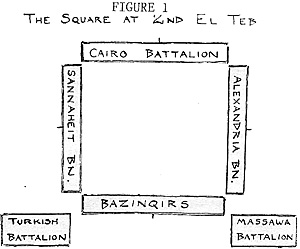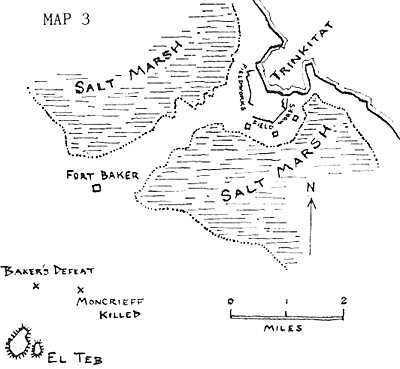By the beginning of February Baker was ready to set out for Takar. Col. Iskander Bey was left in command of Suakin with 108 men of the Cairo battalion, 68 of the Alexandria battalion, 72 Massawa Sudanese, 639 of the 2nd battalion of bazinqirs, 320 old soldiers, 107 of the 1st battalion of bazinqirs, 35 of the Turkish battalion, 50 bandsmen, 186 gunners, 33 Turkish cavalry and 54 Arab cavalry (of which only 34 had horses). On 1 and 2 February the rest of the army left Suakin for Trinkitat, and on 3 February they camped at Fort Baker, some three miles inland from Trinkitat (see map 3).
The entire force numbered some 1,300 Egyptian
gendarmerie (divided about equally between the Cairo and
Alexandria battalions), 900 Sudanese infantry (about 450 each
from Massawa and Sannaheit), 500 bazinqir , 400 'Turkish'
infantry (including some 200 untrained troops sent straight from
Suez to Trinkitat), 300 Egyptian cavalry, 150 bashi-bazuk cavalry,
about 40 European police under Italian officers, 4 Krupps, 2
gatling guns and 2 rocket tubes under Capt. Forrestier Walker.
(3)
The camp at Trinkitat was left with a guard of 200
Egyptians and 300 "Shageer' (Sha'iqiya?) Arabs sent straight
from Egypt and armed with double-barrelled smoothbore muzzle-loading muskets. Two of the Krupps and part of the Massawa
battalion were left at Fort Baker (Sartorius; 230-1).
The force marched out on 4 February 1884 in three
battalions in echelon, companies marching in columns. The
artillery (including the gatlings) were escorted by two companies
of the Alexandria battalion and 40 European police, while the
camel train in the rear was escorted by 200 bazinqirs. The
Egyptian cavalry were deployed to the front and the left, while the
bashi-bazuks were in the front (Rayle: 108; Wingate: 95).
(4)
The march was partially obscured by occasional rain,
and the column struggled across undulating ground with high
misosa bushes further obscuring their vision. At about six miles
out two flags were spatted an the top of the next rise. The Krupps
fired three rounds in their direction and a force of Beia camel and
horsemen were noticed trying to work around the right flank.
Major Giles and the bashi-bazuks were sent out to intercept
them, but the Beja led thee on across the front of the column and
to the left until they found themselves among the main body of
ansar, some 1,000-1,200 men under Abdallah ibn Hasid, hidden
behind the rise.
The bashi-bazuks became disordered and scattered
and started riding back over the hill with the ansar cooing quickly
behind thee. The Egyptian cavalry scouts opened fire, hitting a
number of bashi-bazuks, before they, too, were attacked by the
Beia. The Egyptian cavalry now turned and fled.
Into Square
The infantry were ordered into square. The Cairo
battalion formed the front face, but two companies of the
Alexandria battalion on the right refused to save. The Sannaheit
battalion first tried to deploy to the front and then had to be
wheeled back to sake the left face. The bazinqirs in the rear were
too mixed up with the baggage animals to fore anything properly.
Both the Turkish and Massawa battalions formed their individual
squares quickly. Troops began firing before the square was fully
formed, covering the formation in smoke.
The Cairo and Alexandria battalions broke and began to run
only eight minutes after the rush began; they surged against the
Sannaheit battalion and the bazinqirs, disorganized the Hassawa
battalion square (which was so placed as to be unable to fire on
the enemy). The Sannaheit battalion was forced back on the
Turkish square, taking part of it with them, but the Turks
reformed. The guns had no time to fire before the European
police escort were attacked and died fighting, almost to a man.
Sartorius and Col. Ahead Kamal Bey tried to rally the
gendarmerie, but they were carried away for 200 yards by the flood
of men. Baker sent Sartorius back to the fort to try to stop the men
as they passed, and he shot down many as they ran by. The
Sudanese and the Turks stood for a while but
then began to retreat.
Only the Sudanese infantry stopped
occasionally to turn and fire during the flight.
The army was pursued for five miles by the
ansar. Those who survived the flight all
embarked immediately on arriving at Trinkitat.
Out of a force of some 3,715 men, about 2,373
were killed. Two Krupps, 2 gatlings, 3,000
Resingtons and about half a million cartridges
were captured by the victorious Beja. The ansar
lost some men, including Muhammad ibn Ali,
brother of al-Khidr, commander of the forces
besieging Tokar. The ansar were outnumbered by
the Egyptians by about 3 to 1, and none of the
ansar were then armed with rifles (Sartorius:
233-41; Haggard: 128-31; Royle: 108-117;
Wingate; 95-6; Shaked: 137).
Aftermath
The remnants of Baker's army returned to
Suakin on the night of the 5th. On the 6th
Admiral Hewitt landed a force of sailors and
marines with gatling guns and Nordenfeldts to
help protect the city, which otherwise had less
than 3,000 scared and demoralized soldiers to
defend it. On the 9th Suakin was declared in a
state of siege, Admiral Hewitt was given
complete military and civil powers over the
town, and Britain pledged herself to defending
the town from attack.
All of this made little difference in
the interior. On 8 February the Sinkat
garrison, having eaten all its animals, spiked
its guns and tried to fight its way to Suakin,
taking with it over 200 women and children. The
force was attacked a mile out of town and
annihilated, Tawfiq Bey being killed with them.
On 23 February 1884 the Tokar garrison case to
an understanding with al-Khidr ibn Ali and
handed over the fort, Only Kassala continued to
hold out.
The first phase of the war in the
Eastern Sudan had case to an end. Egypt was
almost completely expelled from the coast.
Britain could no longer avoid intervening.
Wars in Eastern Sudan Part 2: Baker & El Teb
 In case of attack the Cairo battalion was to form the
front face of the square, the Alexandria battalion the right, the
Sannaheit battalion the left, and the bazinqirs the rear. The
Massawa battalion and the Turkish infantry were to form battalion
squares of their own on the flanks of the main square (Sartorius:
2323).
In case of attack the Cairo battalion was to form the
front face of the square, the Alexandria battalion the right, the
Sannaheit battalion the left, and the bazinqirs the rear. The
Massawa battalion and the Turkish infantry were to form battalion
squares of their own on the flanks of the main square (Sartorius:
2323).
 By the time the bashi-bazuks and the Egyptian cavalry
began rushing into the square only the front, left and part of the
rear faces were formed. The Cairo and Alexandria battalions
began to dissolve as the cavalry rode through them. The left front
and left faces of the square were the first to be hit by the ansar.
By the time the bashi-bazuks and the Egyptian cavalry
began rushing into the square only the front, left and part of the
rear faces were formed. The Cairo and Alexandria battalions
began to dissolve as the cavalry rode through them. The left front
and left faces of the square were the first to be hit by the ansar.
Re-inforcements
Second Battle of El Teb
Troops and Tactics
Uniforms
Illustration: Egyptian Troops from Eastern Sudan (166K)
Wargame Ideas
Footnotes and Bibliography
Back to Table of Contents -- Savage and Soldier Vol. XIX No. 2
Back to Savage and Soldier List of Issues
Back to MagWeb Magazine List
© Copyright 1987 by Milton Soong.
This article appears in MagWeb.com (Magazine Web) on the Internet World Wide Web.
Other articles from military history and related magazines are available at http://www.magweb.com